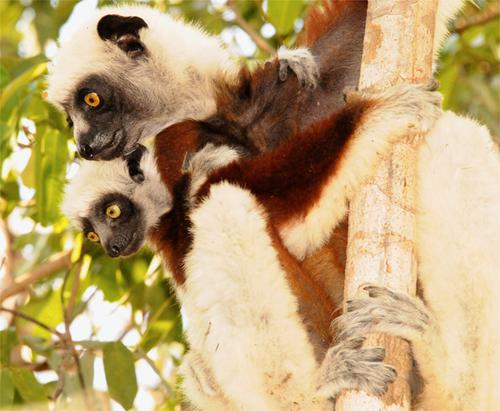当前位置:
X-MOL 学术
›
Am. J. Primatol.
›
论文详情
Our official English website, www.x-mol.net, welcomes your
feedback! (Note: you will need to create a separate account there.)
Lactating Coquerel's sifaka (Propithecus coquereli) exhibit reduced stress responses in comparison to males and nonlactating females.
American Journal of Primatology ( IF 2.0 ) Pub Date : 2020-01-29 , DOI: 10.1002/ajp.23103 Abigail C Ross 1
American Journal of Primatology ( IF 2.0 ) Pub Date : 2020-01-29 , DOI: 10.1002/ajp.23103 Abigail C Ross 1
Affiliation

|
Cortisol is a glucocorticoid hormone that plays a principal role in metabolic function and stress responses in wild primates. Stressors are ubiquitous in environments and elicit a variety of physiological and behavioral responses. While stress responses are adaptive in the short‐term, they can have negative effects when experienced over longer durations. As a physiological stressor, the process of lactation is an energetically expensive activity for mammals. Milk production increases water loss and increased hydration demands are amplified in mammalian species inhabiting xeric habitats, including lemur species living in northwestern Madagascar—the region for this research work. Here, sifakas give birth during the dry season (May–October) and wean infants during the subsequent wet season (November–April). The author collected fecal samples during the 24 weeks following infant births in 10 groups of Coquerel's sifaka in Ankarafantsika Park, Madagascar. The author analyzed the samples by comparing the first 12‐week time block to the second 12‐week time block, which corresponded to the dry and the beginning of the wet seasons, respectively. Analyses were based on 375 samples collected over two birth seasons (2010 and 2011). A linear mixed model determined the relationships between reproductive class and temporal cortisol variation. The three reproductive classes had significantly different cortisol concentrations. Lactating females had lower cortisol than adult males and nonlactating females in all weeks postnatal. Males had significantly higher cortisol in weeks 13–24 relative to weeks 1–12. Examining seasonal changes in cortisol concentrations demonstrates how lemurs respond physiologically to the energetic constraints of lactation during the critical life history stage of infant development.
中文翻译:

与男性和非哺乳期雌性相比,哺乳期Coquerel的sifaka(Propithecus coquereli)表现出降低的应激反应。
皮质醇是一种糖皮质激素,在野生灵长类动物的代谢功能和应激反应中起主要作用。压力源在环境中无处不在,并引发各种生理和行为反应。虽然压力反应在短期内具有适应性,但在较长的时间里会产生负面影响。作为生理应激源,泌乳过程对于哺乳动物而言是能量上昂贵的活动。牛奶生产增加了水分的流失,并且在干燥的生境中生活的哺乳动物物种,包括生活在马达加斯加西北部的狐猴物种,也增加了水合作用的需求。在这里,sifakas在旱季(5月至10月)出生,在随后的雨季(11月至4月)断奶。作者在马达加斯加安卡拉凡蒂卡公园的10组Coquerel sifaka婴儿出生后的24周内收集了粪便样本。作者通过比较第一个12周的时间段和第二个12周的时间段(分别对应于旱季和雨季的开始)来分析样本。分析基于两个出生季节(2010年和2011年)收集的375个样本。线性混合模型确定了生殖类别和时间皮质醇变化之间的关系。这三个生殖类别的皮质醇浓度显着不同。在产后的所有星期中,哺乳期女性的皮质醇水平均低于成年男性和非哺乳期女性。男性在13-24周的皮质醇水平明显高于1-12周。
更新日期:2020-01-29
中文翻译:

与男性和非哺乳期雌性相比,哺乳期Coquerel的sifaka(Propithecus coquereli)表现出降低的应激反应。
皮质醇是一种糖皮质激素,在野生灵长类动物的代谢功能和应激反应中起主要作用。压力源在环境中无处不在,并引发各种生理和行为反应。虽然压力反应在短期内具有适应性,但在较长的时间里会产生负面影响。作为生理应激源,泌乳过程对于哺乳动物而言是能量上昂贵的活动。牛奶生产增加了水分的流失,并且在干燥的生境中生活的哺乳动物物种,包括生活在马达加斯加西北部的狐猴物种,也增加了水合作用的需求。在这里,sifakas在旱季(5月至10月)出生,在随后的雨季(11月至4月)断奶。作者在马达加斯加安卡拉凡蒂卡公园的10组Coquerel sifaka婴儿出生后的24周内收集了粪便样本。作者通过比较第一个12周的时间段和第二个12周的时间段(分别对应于旱季和雨季的开始)来分析样本。分析基于两个出生季节(2010年和2011年)收集的375个样本。线性混合模型确定了生殖类别和时间皮质醇变化之间的关系。这三个生殖类别的皮质醇浓度显着不同。在产后的所有星期中,哺乳期女性的皮质醇水平均低于成年男性和非哺乳期女性。男性在13-24周的皮质醇水平明显高于1-12周。











































 京公网安备 11010802027423号
京公网安备 11010802027423号